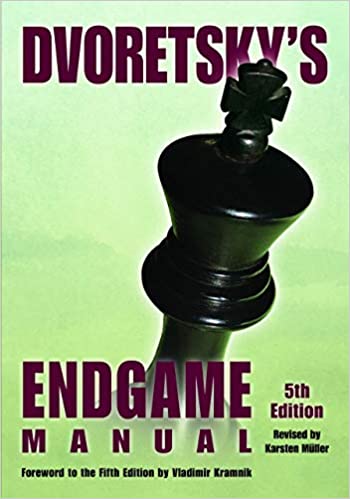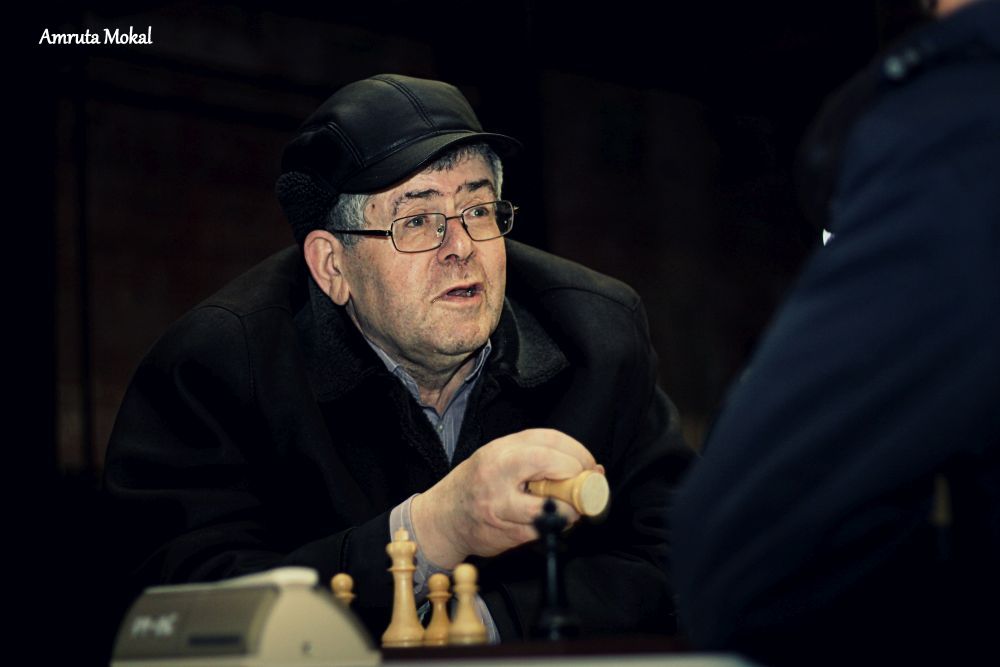


Johannes Fischer: Hello Karsten, you are considered as one of the world’s greatest endgame experts. Recently the fifth edition of the legendary Endgame Manual by the late Russian trainer Mark Dvoretsky was published, and you edited this new edition. The first Russian version of the book appeared in 2002. What makes this book so special that there are now five editions?
Karsten Müller: It is one of the best chess books of all time. It has become popular because Dvoretsky has succeeded in presenting endgame knowledge in a way that makes studying it fun.
The book claims to be an Endgame Manual. Etymologically "Manual" describes "a small book such as may be carried in the hand". Is Dvoretsky’s "Endgame Manual" indeed a manual in the sense that it is small and compact? And does it fulfil its promise of providing basic endgame information in an easy way?
In his introduction Dvoretsky described the aim of the book as follows:
All one needs is thorough knowledge of a limited number of 'precise' positions (as a rule, elementary ones) plus some of the most important principles, evaluations, and standard techniques. The question is, how to select the most important material from the thousands of endings analyzed in various handbooks? That is why this book was written: it offers the basic information you need as the foundation of your own personal endgame theory.
Of course, with by now 440 pages it has become a bit unwieldy, but it is still good to hold in your hand...
How does the fifth edition differ from previous editions? What was added, what was left out?
This cannot be answered comprehensively in a short interview. I went through all the examples and the text and, in consultation with Alex Fishbein, I changed many small things and corrected a couple of translation errors. But I would also like to mention some chess related issues, in which examples were refined and corrected:
Before his untimely death in 2016, Dvoretsky had created a list of corrections, and Chessable gave us access to the comments of their readers, who had worked through the book and found improvements and alternatives to Dvoretsky’s solutions. Erwin L'Ami was also helpful and he sent me a mail with analyses and remarks about a number of positions. His analysis of the so-called Steckner position is particularly important.
In general, it can be said that the Vancura type defences were underestimated by the old literature. L'Ami's new defense in the Steckner position (see 9-168a) is a Vancura type defence, similar to Anish Giri's new defence (see 9-208e).
Alex and I checked all exercises in the book carefully. We removed some of the old, and also changed some to have only one exact solution for each exercise.
Alex also restructured the whole Kantorovich / Stecker discussion, which is now easier to understand. The discussion of the Philidor position (9-17a) is now clearer and has more diagrams – after all, this is one of the most important positions of the entire endgame theory. Philidor's second defensive method (which I usually call Karstedt's defence) is now presented in a much clearer way.
Of course, we usually stick to Dvoretsky's way of naming the endgames and the endgame patterns he analyses, but we added some terms. One such term is "shouldering", a manoeuvre which I call "bodycheck" in my works. We decided to add "my" term so that readers are not confused when they study Dvoretsky’s Endgame Manual and later one of my books or DVDs.
In the chapter about knight endgames we also made a lot of discoveries, e.g. in the very famous example Lasker vs Nimzowitsch (3-7).
We came to the conclusion that a pawn majority of 4 vs 3 on the kingside in this endgame only gives good winning chances but is not winning as has usually been claimed previously. We also highlighted drawing scenarios.
We formulated Bähr's rule (1-126) more clearly, and we mentioned the exceptions to the rule. Which, by the way, was not an easy task. A bit like formulating and proving a mathematical theorem. Here, Alex and I had long discussions until we were both satisfied. This was a bit like working with Mark – we always reached a solution we all could agree on. And Rausers's drawing zone (4-2) is introduced in its full form to make it clearer.
In the foreword to the fifth edition, Vladimir Kramnik, an outstanding endgame player himself, describes Dvoretsky's Endgame Manual as one of the best books that were recently published. He claims that it is a book for professionals and amateurs alike. Is he right, is the Manual an endgame book for everyone?
I think Kramnik is right. After all, Dvoretsky especially marked the material that everyone should know, outlining a basic endgame course that is less extensive and ideal for amateurs. Professionals should of course dig deeper, and the book offers a lot of material to do so.

Mark Dvoretsky, Dvoretsky's Endgame Manual, 5th edition, revised by Karsten Müller, Russell Enterprises 2020
Dvoretsky died in September 2016, but even during his lifetime he enjoyed a legendary reputation as a coach. However, his books are said to be very demanding. How strong do you have to be, and how much work do you have to do to benefit from Endgame Manual 5?
The more you work with the Endgame Manual, the higher the rewards will be.
And is working with the Endgame Manual worth the effort – and is it fun?
I think it is, and usually I could convince my students that it is indeed.
How useful is it to study endgames in general? I know that many coaches and good players claim that you should study the endgame to get better, but my impression is that most players still spend most of their time studying openings. Which is understandable: after all, every game has an opening, but only some reach the endgame.
But endgames help to get a deeper understanding of the game. The exact strengths and weaknesses of the individual pieces can only be studied in pure form in the endgame. Moreover, rook endgames, for example, very often occur in practice which should be reason enough to study them. And endgame theory hardly changes. You learn it once and you profit for a lifetime.
However, improved engines such as Fat Fritz and the continuously bigger tablebases have changed endgame theory. How did this affect the Endgame Manual?
Of course, this had a great influence on the book. With the help of engines and tablebases we have found a lot of mistakes in previous analyses, especially in knight and in rook endings. But the core of endgame theory is nevertheless more or less constant unlike, for example, opening theory, which is subject to fashions.
You edited the book together with Alex Fishbein. How did you proceed?
I made lists of possible changes, and Alex checked each proposal carefully to see if it is correct and if it is appropriate to change Dvoretsky’s presentation. In the end, we found a compromise on every single point. In consultation with me, Alex also rewrote longer passages in the sections about knight and rook endings.
In this case, the time difference between Hamburg and the USA turned out to be a blessing, and on some days, we could work for almost 24 hours combined. In the morning I often had a lot of emails from Alex and Hanon [Russell], the editor of the Manual, and I could work on their proposals. When they woke up, they could see what I had found out and could revise and check my proposals. And when I went to bed, they could continue their work and they could send me the results during the night.
A lot of books have been written about the endgame. What distinguishes Dvoretsky’s book from these other books?
His material matured over decades, and he extensively tested it in study sessions with countless students. You feel that in the book. On top of that it has a good mix of examples, explanations and a couple of anecdotes.

Analysing enthusiastically: Mark Dvoretsky (Photo: Amruta Mokal)
You are an endgame enthusiast, and you have published a lot of DVDs and books about the endgame. What makes you so passionate about the endgame?
I have a PhD in Mathematics, and endgames are like pure mathematics with some geometry. They have a beauty and fascination of their own. If you find proof, the matter is settled. They do not follow the whims of fashion. Analysing the opening, on the other hand, feels more like statistical math and I have always liked pure math much more.
Do you have a favourite endgame, and is there a player whose way to play the endgame fascinates you in particular?
I would like to give two examples. Both are linked to errors I made. The first one is Shirov vs Lautier, München 1993:
The second one from the first World Championship match between Karpov and Kasparov in Moscow 1984/1985.
If one does not have enough time to study the entire Endgame Manual, what parts should one read to learn the most important basics about the endgame?
The basic course designed by Dvoretsky, that is, the parts marked in grey in DEM 5.
One last question: how can you cultivate and develop your understanding and enjoyment of the endgame?
Decline early draw offers, do not avoid favourable liquidations into the endgame, take a close look at your own endgames, create a database of your own with the most important positions, which you then can go through regularly, and study good books and DVDs about the endgame.
Thanks for the interview!